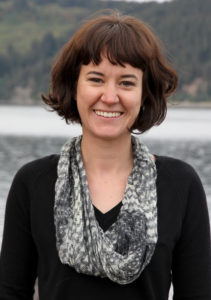By Betsi Oliver
Outreach Coordinator

What makes the difference between youth who develop careers and other roles protecting our ecosystem versus those who don’t?
When youth develop a personal connection to the outdoors, an understanding of and interest in science, and civic engagement experience, they develop into young adults who are engaged, informed, and passionate.
In previous jobs I implemented youth education programs that were supported by the Council. As a mentor for the young participants, I saw that a web of interconnected experiences provides a strong foundation for their development. For a young person, finding a next step gives meaning to the fun field trip they did in elementary or middle school, turning it into their context for participating in Science Bowl, an internship, a volunteer effort, or an academic path.
I’d like to briefly showcase a few youth, some whom I know and some I don’t, who participated in Council-supported youth involvement programs early in their pathway. These young people are the future of leadership in their communities, the region that the Council represents. For clarity, any program that the Council supported is in bold.
Cordova’s Sarah Hoepfner grew up participating in Copper River Watershed Project programs so she was a perfect fit to participate in the Copper River Watershed Expedition. In 2013, Sarah served as the very first Council intern in Cordova, monitoring for green crab and other marine invasives in the harbor. She taught environmental education about invasive species locally and at the World Wilderness Congress with Council volunteer, Cathy Hart. She now studies biology with an emphasis in ecology and biodiversity at Humboldt State.
When Alejandro Soto was invited to participate in an Alaska Geographic Habitat Restoration Kayak Expedition, he was still learning English after moving to Anchorage from the Dominican Republic at age 13. Through Alaska Geographic’s mentorship program, he became an Arctic Youth Ambassador and has spoken with leaders at the U.S. Departments of State, Interior, and Agriculture as well as to international environmental ministers in Finland. He has presented at the National Wilderness Conference and the American Planning Association. He is a member of the National Park Conservation Association Next Generation Advisory Council and is a Doris Duke Conservation Scholar. He is working on a degree in environmental studies with a concentration in social science at the University of Alaska in Anchorage.
Deborah Bitanga helped the U.S. Fish and Wildlife Service’s Summer Science and Salmon Camp reach out to youth in Kodiak, especially immigrants. Council volunteer Jane Eisemann coached Deborah’s team for the Tsunami Bowl, a statewide ocean sciences competition, and participated in a short film she made about the impacts of the Exxon Valdez spill on Kodiak 25 years later. Eisemann nominated her to participate in a kayaking program in Prince William Sound with the Chugach Children’s Forest. Deborah became a Gates Millennium Scholar at Evergreen College and participated in the elite two-year Doris Duke Conservation Scholars Program at University of Washington. She is currently in her senior year, studying political economy and education.
Axel Gillam from Homer participated in and helped lead Center for Alaska Coastal Studies’ discovery labs in elementary school. As a middle schooler he trained to respond to stranded marine mammals. In high school, he was on Homer’s team for the Tsunami Bowl. He was once hired by Lisa Matlock, before she worked for the Council, as a summer intern with Youth Conservation Corps, during which he did science and environmental education at culture camps in the Aleutians. Later he became a seasonal educator at the Center for Alaskan Coastal Studies and taught oil spill science through their Marine Technology and Research program. He is currently a marine biology upper class student at University of Alaska Southeast.
These are just four of many similar stories of youth who are on a path to meaningful careers and civic participation on behalf of their communities. Each young person who develops a personal connection with the Exxon Valdez region, the history of the oil spill, and the science of prevention and response, brings that awareness forward into every next opportunity and a lifetime of informed citizen engagement. I’m pleased to be a part of this Council, which, through its youth involvement projects and a dedicated team of volunteers serving as mentors in our communities, is taking a leadership role in cultivating our next generation of leaders.